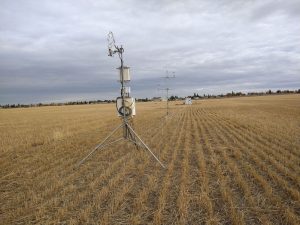Saskatchewan Bulletin
New Research Projects Contribute to Grower Profitability
At SaskCanola, research continues to be a strategic priority, with about 40 per cent of SaskCanola’s annual budget allocated to this pillar. Since the establishment of SaskCanola in 1991, Saskatchewan canola producers have funded over 426 studies related to canola agronomy, trait development, alternative uses and more, with the goal to improve canola profitability.
Why is research important to farmers?
For one, it gives growers a competitive edge. Research is essential to stay competitive in the global oilseed market and keep ahead of canola threats such as diseases and abiotic stress. Where would we be as an industry without several decades of blackleg research?
Research initiatives make levy dollars go farther because growers can access matching funds. Governments and other funding entities provide capital that exceeds the amount levies bring to the research program. We increase growers’ investment by leveraging levy money an average of 3:1 with co-funders.
Projects can generate and strengthen producer group partnerships. We create partnerships with other canola producer groups in Western Canada and sometimes other Saskatchewan commodity groups to share the cost of research. This ensures levy dollars work together to solve whole farm integrated producer issues.

Research initiatives support producer-identified issues. Growers are given the opportunity to provide direct input into research priorities to ensure investments are beneficial to their farm operation. At times, SaskCanola funds projects because producers need answers – it may not attract other funding contributors but we believe it is necessary to get it done, so full funding is provided.
New projects
Eight newly funded Agriculture Development Fund (ADF) projects were announced on January 12. The projects and their implications for growers are:
- Impact of Phosphorus Fertilizer Forms on Nutrition of Wheat, Pea and Canola, Soil Fate and Losses in Run-Off Water – This project will assess how phosphorus fertilizer forms, placement and rate affect crop responses, fate in the soil and run-off losses in Saskatchewan soils.
- Identification and exploitation of genome structural variants for trait improvement in Prairie crops – This builds on our understanding of the development of canola (Brassica napus) and wheat (Triticum aestivum L.) pan-genome structural variant (PanSV) atlases.
- Developing single-spore isolates of pathotypes of Plasmodiophora brassicae – Researchers will develop techniques for whole-genome sequencing of single spores of Plasmodiophora brassicae.
- Shining Light on Digital Agriculture: Linking Soil NIR measurements, Fertility and Crop Yields – This project will use spectral sensing to produce spatially-resolved soil-based yield potential maps, and will develop methodology to link field near infrared (NIR) data and laboratory analyses.
- Enhancing the Saskatchewan Soil Health Assessment Protocol – Phase 2 – This will build on the Saskatchewan Soil Health Testing Protocol so that it outputs soil zone-specific scores, incorporates novel microbial measurements of soil health, and explores early-indicators of soil health change for when producers incorporate regenerative agricultural practices on farm.
- Collecting the carbon data needed for Climate-Smart agriculture in Saskatchewan – Researchers will provide direct, year-round field-scale measurements of greenhouse gas emissions from a representative cropping system in Saskatchewan, and test the hypothesis that Saskatchewan cropping systems are a net carbon sink by determining net ecosystem exchange and carbon footprint.
- Application of hyperspectral imaging for detection and mapping of small patch clubroot infestations in commercial canola fields – This study focuses on identifying readily applied diagnostic features for mapping small clubroot patches and developing a diagnostic tool for identifying small patch clubroot infestations.
- Continuing to watch the winds: the origin and arrival of migrant aster leafhoppers and diamondback moths – Researchers will assess the genetic variations of migrant and new generations of diamondback moth and aster leafhopper to pinpoint their southern origins. They will use wind trajectories and stable isotopes to continue gathering data on diamondback moth and aster leafhopper migration flights and origin.
SaskCanola research results are posted to our online database. Both short and long reports are available. For more information, contact Doug Heath, research manager, at (306) 975-0730/dheath@saskcanola.com, or Miki Miheguli, research extension specialist, at (306) 975-0273/mmiheguli@saskcanola.com.
Be in the know!
For the latest canola news and information, subscribe to SaskCanola’s newsletter at saskcanola.com.





